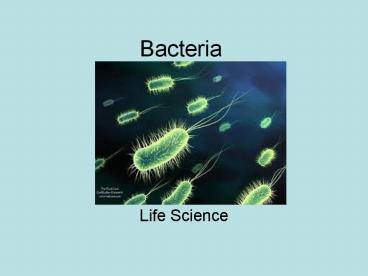Bacteria - PowerPoint PPT Presentation
Title:
Bacteria
Description:
Title: Bacteria Author: jason matthew burton Last modified by: E200100576 Created Date: 11/28/2004 6:21:47 PM Document presentation format: On-screen Show (4:3) – PowerPoint PPT presentation
Number of Views:79
Avg rating:3.0/5.0
Title: Bacteria
1
Bacteria
- Life Science
2
What type of cell are bacteria?
- Prokaryotic
- No Nucleus or membrane bound organelles.
3
What are the two groups of bacteria?
- Eubacteria
- Good or true bacteria.
- Live Everywhere
- Cell wall with peptidoglycan
- Archaebacteria
- Old bacteria
- Live in Extreme Environments (hot springs, high
salt concentrations, etc) - Cell wall without peptidoglycan
4
What are the 8 basic parts of a bacteria?
- Nuclear Material (DNA)
- NO NUCLEUS!!!!
- Cytoplasm
- Ribosomes
- Capsule
- Cell wall
- with and without peptidoglycan
- Gram positive and gram negative (only Eubacteria)
- Cell(plasma) membrane
- Pilus
- Flagella
5
What are the three basic shapes of bacteria?
- Cocci round shape
- Streptococcus
- Bacilli rod shape
- Clostridium botulinum
- Spirillum spiral shaped
- Spirillum volutans
6
How bacteria arrange themselves?
- Type of arrangementtype of bacteria how they
hangout - Arrangement
- Diplo in pairs
- Strepto in a chain
- Staphylo in clusters
- Example Diplobacillus rod shaped in pairs
- Streptococcus circular shape in chains
- Staphylobaccillus rod shape clusters
7
Arrangement
- Streptococcus Chain, round
8
Arrangement
- Streptobacillus Chains, rod
9
Arrangement
- Dicoccus Two, round
10
Arrangement
- Staphlococcus Clusters, round
11
What is a flagella?
Use for locomotion
12
What ways do they move?
- Flagella
- Long whip-like tail (shown)
- Slime
- Slime layer used to slide
- Spiral Movement
- Spiral twisting
- No Movement
13
What two ways do bacteria reproduce?
- Asexual
- Binary Fission
- Identical Cells
- Sexual (pseudo)
- Conjugation then
- binary fission
- New Genetically Different Cells
14
How do bacteria obtain food?
- Autotrophic
- Make it themselves with the help of light or
inorganic matter and chemicals - Heterotrophic
- Breakdown food, dead or decaying matter (organic
matter). - Decomposer
- The skeletal remains of large whales are home to
a unique genus of gutless polychaete worms called
Osedax. These worms harbor heterotrophic bacteria
that degrade lipids in whale bones to provide
their host with nutrition.
15
Do bacteria need oxygen?
- Yes
- Some need oxygen to help break down food.
- No
- Some cannot use oxygen and it is like poison to
them and kills the bacteria.
16
Can bacteria protect themselves?
- Yes!
- Endospore
- A small, rounded, thick-walled, resting cell
- It contains the cells genetic material and some
of its cytoplasm. - It can resist freezing, heating, and drying, they
can survive for many years
17
What good do bacteria do for the planet?
- Fuel
- Some Archaebacteria produces methane (landfills)
- Food
- Bacteria assist in making food such as yogurt,
pickles, cheese, apple cider. - Recycling
- Breaking down dead and decaying matter
(decomposer). - Some bacteria are used to clean up oil spills.
- Symbiotic Relationships
- E. Coli producing Vitamin K in Human Intestines
- Cow gut- to break down grass
18
Microbial Friends
Escherichia coli Aids in food digestion
Lactobacillus acidophilus Turns milk into yogurt
Streptomyces Makes streptomycin, an antibiotic
19
What are some bad things bacteria do on the
planet?
- Spoil food
- Cause Disease
- Food Poisoning
- Tetanus
- Lyme Disease
- Strep Throat
- Tuberculosis (TB)
- Producing toxins that harm living things.
20
How can you treat and prevent bacterial diseases?
- Antibiotics
- A chemical that kills bacteria or slows their
growth without harming the body cells of humans - Vaccines
- A substance used in a vaccination that consists
of pathogens that have been weakened or killed
but can still trigger the immune system into
action.































